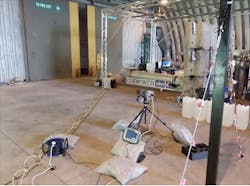Rocket test captured at high speed
Last year, a team of engineers behind the UK's Bloodhound SSC jet and rocket powered supersonic car carried out a test of the vehicle's unique hybrid rocket system at the Aerohub at Newquay Cornwall Airport.
At 12 feet long, 18 inches in diameter and 450kg in weight, Bloodhound’s rocket is the largest of its kind ever designed in Europe and the biggest to be fired in the UK for 20 years.
During the test, which was streamed live to the web, the rocket burned for 10 seconds, generating 14,000 lbs of thrust, the equivalent of 30-40,000hp. Sound levels at the rocket nozzle reached 185 dB, many times that of a Boeing 747 at take off.
To enable the designers of the rocket to analyze the burn of the rocket, eight Olympus (Southend-on-Sea, UK) i-SPEED 3 video cameras were placed around the rocket to capture high-speed images. The cameras were set to record at 500 frames per second with a 400 microsecond shutter speed and an exposure of F16.
On firing, the rocket produced a plume some 15 feet long. Despite melting the lenses on some of the i-SPEED cameras due to their close proximity to the plume, all eight recorded slow-motion video footage which will prove invaluable to the designers of the rocket.
The Bloodhound SSC is a jet and rocket powered car designed to travel at 1,000 mph. It has a slender body of approximately 14m length with two front wheels within the body and two rear wheels mounted externally within wheel fairings. It weighs over 7 tonnes and the engines produce more than 135,000 horsepower.
Related items on high-speed imaging that you might also be interested in reading.
1. Time-of-flight camera captures VGA images at high speed
Time-of-flight (ToF) cameras resolve distance measurements by measuring the time of flight of modulated light that is reflected from the object in the camera's field of view.
2. High-speed imaging helps predict fluid behavior
Using a high-speed imaging technique, scientists from Cambridge University (Cambridge, England) have developed a means of predicting whether a filament of fluid from a print head will condense along its length into a single droplet, or collapse into multiple droplets.
3. Camera system captures high-speed phenomena and measures temperature
Many camera companies offer the capability to image events at high speed, but one company has taken the technology one step further, enabling its users to rapidly capture images and precisely measure the temperature at different points during a high-speed event.
-- Dave Wilson, Senior Editor, Vision Systems Design
